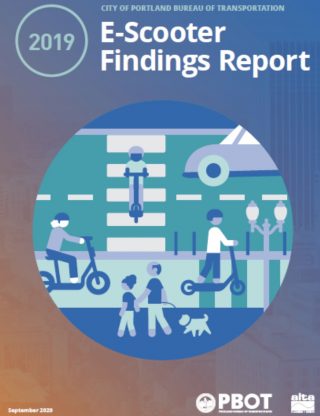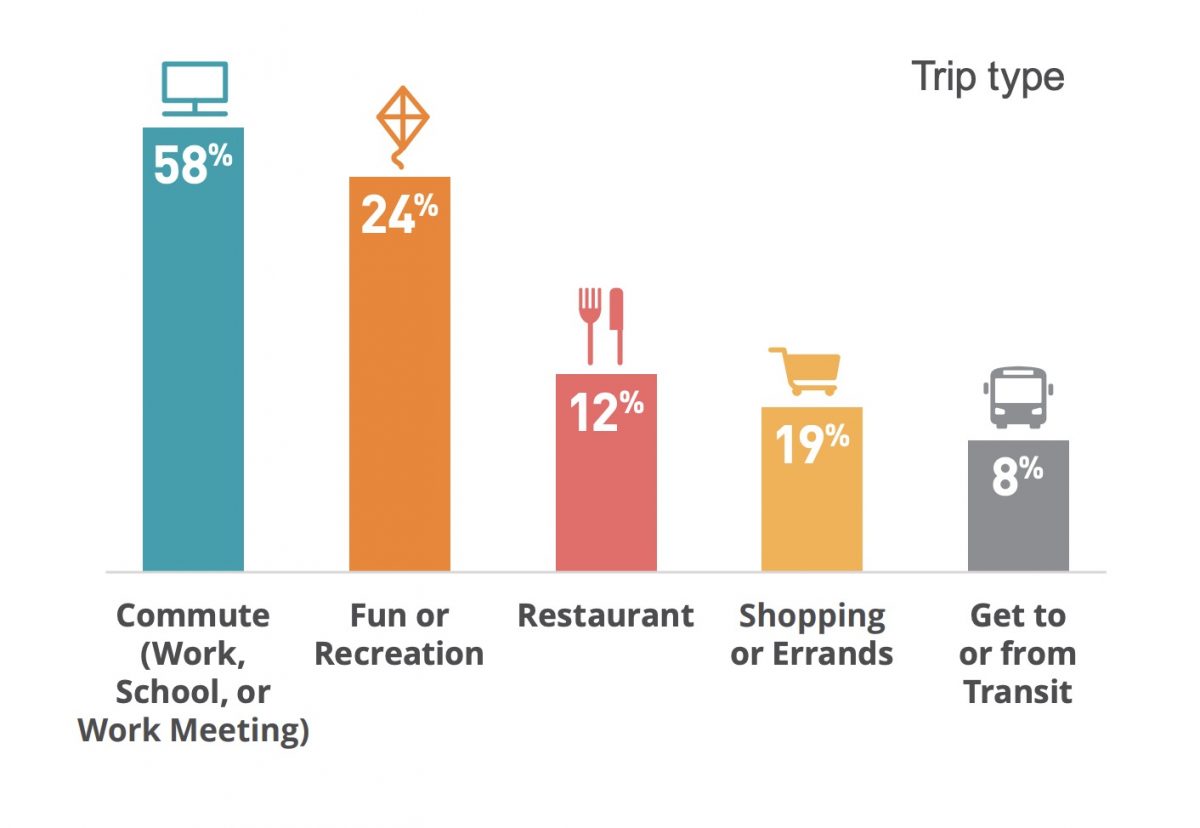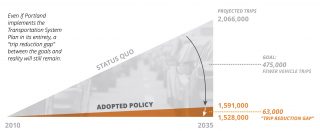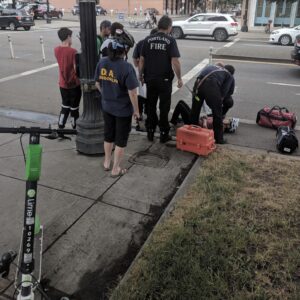
(Photo: City of Portland)

The winding road of shared electric scooters in Portland has taken another turn. Today the transportation bureau released a report (PDF) on scooter usage and outlined plans for a permanent system. Among the findings is that cycling-specific infrastructure is key to boosting scooter ridership, especially in places with high-stress streets like east Portland.
Portland launched e-scooters in summer 2018 as a pilot program. The Portland Bureau of Transportation deemed them a success and launched a second pilot in spring 2019 that’s set to end on December 31st.
With lessons learned in courtship and positive signs that the scooters are a needed and valuable part of Portland’s transportation ecosystem, PBOT wants to settle down with fewer partners and a longer-term commitment. There are currently six different companies offering scooters in Portland. This is clunky for both users and PBOT staff to manage. A key recommendation in the report released today says PBOT wants to work with 1-3 companies for the next 2-3 years.

Among the takeaways in the report is the impact of bike infrastructure on scooter usage. Not only did PBOT find that the presence of bike lanes led to much less sidewalk-scootering, GPS data shows 32% of all scooter mileage took place on protected bike lanes, unprotected bike lanes, bridge bikeways, paths, and/or neighborhood greenways. “E-scooter riders feel more comfortable when there is safe infrastructure to ride separate from cars,” states the report.
PBOT was also able to compare how ridership data changed with the construction of bike infrastructure that was built between the first and second pilots. In Waterfront Park for instance, the construction of Better Naito in 2019 led to a 55% increase in riding on Naito and a subsequent 45% decrease on the park path (this also had to do with signage warning people to stay out of the park and some “geofencing” from scooter vendors).
Advertisement
The new protected bike lanes on the Halsey-Weidler couplet in Gateway also appear to have impacted scooter usage. PBOT analysis shows a 125% increase in trips between 2019 and 2018. And on 102nd where new bike lanes were installed, there was a 22% boost in ridership. These increases come even as overall e-scooter ridership was lower in 2019 than 2018.
These findings show that cycling advocates would be wise to embrace scooter riders in order to strengthen and diversify their push for more dedicated infrastructure. “Bicycling is often associated with white-dominant culture,” PBOT writes in the report, “and e-scooters may or may not share that association.”
The recommendation of a permanent program makes it clear the City of Portland sees scooters as an integral part of the modal mix.
While some scooter trips replace bike trips, data reveals that scooters fill a different need: The average trip length for e-scooter riders is just over one mile and less than 14 minutes; the average (non-electric) bike share trip is over two miles and 25 minutes.
With the climate change catastrophe staring us directly in the face these days, PBOT also sees scooters as a key way to reduce car abuse. The city’s Transportation System Plan calls for 475,000 fewer daily car and truck trips by 2035. However even if we succeed with adopted plans, we’ll still come up with a “trip gap” of 63,000 daily trips (see graph at right). “If new mobility services like e-scooters can provide an attractive option that reduces car use and car ownership, they may help close this ‘trip gap’ and meet city congestion and climate goals,” states the report.
And of course e-scooter trips are much more earth-friendly than car and truck trips. PBOT estimates scooter riders have helped Portland lower carbon emissions by 167 metric tons and have removed the equivalent of 27 passenger cars and trucks from the streets over the 2019 pilot period.
Along with the report, PBOT released a scooter data dashboard and survey. Get all the info and links here.
— Jonathan Maus: (503) 706-8804, @jonathan_maus on Twitter and jonathan@bikeportland.org
— Get our headlines delivered to your inbox.
— Support this independent community media outlet with a one-time contribution or monthly subscription.











Thanks for reading.
BikePortland has served this community with independent community journalism since 2005. We rely on subscriptions from readers like you to survive. Your financial support is vital in keeping this valuable resource alive and well.
Please subscribe today to strengthen and expand our work.
While PBOT is busy making reports and doing studies, other cities are taking action. Just today Paris announced they’re permanently banning cars from Rue de Rivoli. This video is proof that “if you build it, they will come:” https://twitter.com/BrentToderian/status/1306369401361293312
THIS IS DISGUSTING. GET YOUR MOTORIZED VEHICLE OUT OF THE BICYCLE LANE. RIDING ON SIDEWALKS IS NOT BAD ENOUGH. WELCOME TO THE LAZIEST SOCIETY EVER. YOU ARE NOT SAVING THE PLANET.
If it takes a step closer to making cars a minority, then it’s a good thing.
If by “lazy” you mean people recovering from accute/ long term injuries (knee, back, neck, ), or chronic pain/ fatigue, diabetes complications, among numerous other reasons people can’t ride a bike on a particular day they need to get across town….cool, they have every right to hop into there 3 ton SUV and make the trip…rad?….not really. I’d prefer they took a scooter.
Oh hey, something we already knew! PBOT loves to study things. Of course, they aren’t going to actually build any bike infrastructure, because that would potentially making driving harder, which is unacceptable.
Just more greenwashed nonsense from a regressive transportation agency.
You slave paying taxes to pay pbot to park butt in front of god 19″ all day planning a giant disaster known as portland.
Really ?
Word salad.
If parking and traffic are as bad as people say (and I think they are), not sure why we’d assume all these rides are replacing car trips. An abled bodied person can walk that distance in practically the same amount of time, especially after the logistics of dealing with the scooter are factored in. And the cost per mile is nuts.
Having said that, I don’t mind riding on roads and paths with them. Between motors that keep them moving at consistent speeds and poor handling characteristics, I find they move more predictably than most cyclists.
In other news, water is wet. Can’t believe that this study actually had to be done, it’s so commonsense. I really wish PBOT would spend money on actual infrastructure instead of studies like this.
Meanwhile, my new city of SLC has over the past few years been removing car lanes and/or parking from multiple wide streets and converting them to bike lanes, wide sidewalks, medians, and other infrastructure, with more projects slated for the next few years. PBOT is seriously falling behind.
Ah.. to have a 130 feet of street width to work with. I remember when I learned that the streets in SLC were built wide enough to turn a full horse-wagon team around, blew my mind. Portland’s streets are typically somewhere closer to 40 – 60 ft wide – with the largest arterials reaching 72 feet, still about half the width of SLC. I should hope they are getting a remake, I remember it being an awfully long haul across a street when I visited.
True true, we definitely have it a bit easier over there on that front 🙂 It’s actually super easy to tell which streets are owned by SLC vs which are owned by UDOT. The SLC streets are really quite nice for active transportation, and the bus system is great. I can find a nice bike route to pretty much any location I want within the city. The UDOT streets…well let’s just say that UDOT makes ODOT look like saints. They even had an official spokesperson complain about the “war on cars” a bit ago.
Saying Portland has virtually no protected infrastructure because of street width would preclude most of the cities in Europe. Portland lacks safe infrastructure because of lack of political will and the prevailing vehicular cycling ideology in the US. That is why most people use cars. Amsterdam looked pretty close to Portland in the 70s.
I remember a technical field trip to SLC (2000s) to study their street design and city staff told me that SLCs 130Ft streets were ‘too narrow’ to add bike lanes. [Perhaps “politically too narrow” in hindsight.]
Very glad that things seem to have changed since then 🙂
“And of course e-scooter trips are much more earth-friendly than car and truck trips.“
This is a key claim to justify this investment, arrangement, etc. The trouble is it is not really correct.
This study which is very well done explains why: https://iopscience.iop.org/article/10.1088/1748-9326/ab2da8
I know I have linked to it in the past.
Are e-scooters polluters? The environmental impacts of shared dockless electric scooters
It turns out there are a bunch of tweaks that are necessary (longer scooter lifetimes, fuel efficient collection vehicles, attention to charge level when collecting, etc.) necessary to open up the modest environmental difference between cars and e-scooters. There is nothing *automatically* better about them. And it is important to remember that since most of the trips made by these are not substituting for automobiles but for model with lower global warming impacts, the comparison to the car must more than make up for those losses.
From the study’s Results section:
“These results show that dockless e-scooters consistently result in higher life cycle global warming impacts relative to the use of a bus with high ridership, an electric bicycle, or a bicycle per passenger-mile traveled. However, choosing an e-scooter over driving a personal automobile with a fuel efficiency of 26 miles per gallon results in a near universal decrease in global warming impacts. The use of dockless e-scooters are often preferable to dockless bicycles, yielding lower life cycle emissions 67% to 100% of the time across the scenarios. When compared to the Benchmark Displacement CO2 emissions, our Base Case shows a 65% chance that the life cycle e-scooter emissions will be higher. This likelihood is reduced, but nontrivial, for our Low Collection Distance (35%), Battery Depletion Limit (40%), High Vehicle Efficiency (50%), and High Scooter Lifetime (4%) scenarios. These results underscore the importance of ensuring long lifetimes for e-scooters in reducing life cycle emissions.”
Thanks for pointing this out 9watts. Not sure if you’re aware but PBOT is working on LCA stuff. This is from the report linked in my post:
Procuring more data is always good. So I applaud the City for looking into this. But it is worth noting that the study I cited above was very thorough. It already answers most of the questions one might have, and tells us how stunning or how modest the environmental benefits of a scooter trip is, and where the point of leverage are to improve those ratios.
Bottom line: there is no stunning environmental benefit of e-scooters, under the very reasonable assumptions made. There is modest benefit if/when their use substitutes for a car, but since this is the case for a minority of trips, we must remain vigilant, and resist the urge to reflexively congratulate ourselves.
I hope you’re not suggesting that one study is all we ever need on this matter.
To clarify, your own description of the data is positive.
You further cast aspersions by saying,
But I don’t see where your study supports that claim. So, it comes across as a bias.
“I hope you’re not suggesting that one study is all we ever need on this matter.”
Of course I am not suggesting that.
But you might agree that it is incumbent upon anyone proposing to *study the exact same thing within a year or two* (an e-scooter LCA) to explain why, what this study will do that the other one hasn’t.
Especially when the chief insight from the study I cited doesn’t seem to have pierced the boosterist instincts at PBOT, see p. 28 of their report, where they hype the car trip/e-scooter savings but never mention the majority of trips where the e-scooters made in Portland substituted for lower carbon trips. This penchant for tallying only the savings and omitting the costs is the heart of the problem ai am trying to draw attention to, and another LCA may or may not address this.
Your study is a report on the pollution caused by scooters. From manufacture all the way through to retirement. The scope is broad and generic.
The PBOT study has a different scope. It seeks specifically to address serving transportation needs of Portlanders, how scooters can contribute to vision zero and how scooters fit with the multi-modal transportation scene in Portland.
The first rental e-scooters were built like toys and consequently had a lifespan of several months while the current third generation was overbuilt and designed for repairability. Using a study that was based on the pathetically disposable Xiaomi 365/Ninebot ES2 to critique the durability of the current generation of rental scooters is like comparing rotten apples to oranges.
For example, a recent LCA conducted by consultants from the National Renewable Energy Laboratory and CEA to meet SFMTA regulatory requirments found that “Bird Two” e-scooters had a manufacture-to-grave CO2e of 97 grams of CO2 equivalent emitted per passenger mile (gCO2e/pmt). To put this number in perspective, diesel bus transit has higher cradle-to-grave numbers (320 gCO2e/pmt in the comparison data used in this LCA). In fact, this number is lower than many estimates of the gCO2e/pmt of cycling (https://keith.seas.harvard.edu/blog/climate-impacts-biking-vs-driving).
I’d prefer to have LCAs conducted by independent groups not affiliated with local transportation agencies but this is certainly encouraging.
https://www.bird.co/blog/how-to-correctly-assess-environmental-impact-electric-scooter/
This choice passive aggressive quote is telling:
It’s not surprising at all given that concern for sustainability in USAnian cities is entirely performative.
A little faint praise for scooters–some scooter company has a really slick trailer rig, maybe even with on-board charging? Anyway it’s night and day vs. the ‘white vans’ and beaters they were using.
I’m trying to figure out how it makes sense to have people in motor vehicles running all over town so somebody can have an ebike ride. How does that pencil out? Rental ebikes would make more sense if there were charging stations scattered around town, perhaps where bus lines cross, and one ticket or swipe covered everything.
No, I do not care if it takes a subsidy to get it going. The US government created land title for a big chunk of the country and handed it to the railroad companies, remember that one? It cost the Treasury nothing…
Paris has installed scooter hubs with built-in charging. If PBOT were genuinely interested in sustainability this would have been a priority here too.
https://www.web24.news/u/2020/07/in-paris-self-service-scooters-now-have-their-charging-stations.html
Any day of the week, I would prefer to see people riding these scooters versus driving. I would much more prefer if they rode low tech, analogue bikes. I’m not going to balk at more scooters though. If more scooters on the road equates to more bike lanes, great.
Bike mode share slightly decreased to 5.2% according to Census ACS numbers released today. This is almost a 30% drop from the 2014 peak and represents a nominal loss of one fifth of Portland’s bike commuters from that peak (4295 fewer bike commuters out of a total of 23347 in 2014).
Sadly, I think the likelihood that Portland’s council members are going to prioritize cycling infrastructure given these dismal numbers is low.
Perhaps we should go with the corporatist flow and rebrand bike lanes, as e-scooter lanes. We could even sell infrastructure naming rights to corporations. Clinton could become the Nike Greenway and Ankeny the Ford Greenway (owner of SPIN escooters).
Micro-Mobility Lanes
Big surprise that only 1% of scooter use is west of the river, outside of downtown. And that’s partly cuz there haven’t been any scooters stationed here, though lately I’ve seen some scooters (from Spin?) stationed along Multnomah Blvd. I’ve been tempted to take a spin (Spin??) but I have my bike so it’s not really a priority for me, and I continue having trouble seeing how an e-scooter parked on the corner is ever going to replace trips of any type for me (trips by car, where I need to haul heavier stuff and the dog, and trips by bike, where I haul lighter stuff).
Not sure if this point is anywhere in the report, but I think the scooters need docking stations like the ones the Nike Bike-ees have. I see scooters strewn about, blocking sidewalks, which could be caused by scooter-haters to turn The People (esp The Walking People and The Wheelchair-Using People) against scooters. Remove one car-parking space and there’s your scooter docking station. They could make them really attractive, put cameras on them, etc.
7 years ago in an effort to eliminate car use I bought an e-cargo bike (Surly Big Dummy) from Splendid Cycles. That was one of the best decisions I have ever made.
After having experienced the e-scooters enough to find some use for them I just decided to do some research and purchase my own just over a year ago. It has been a year now I have owned a Ninebot Kickscooter Max. This is the same scooter as the Spin scooters. https://store.segway.com/ninebot-kickscooter-max
Although I ride bikes a lot, including my e-Big Dummy, there are many times now where I just hop on the scooter and go, because it is simple, nimble and involves little effort. I have a theory that unlike bikes, e-scoots appeal to Americans desire to be sedentary. Generations of automotive infrastructure and car dependence have made us lazy. Unfortunately that will not change over night.
Unlike the shared scooters that seem to get trashed routinely and get abused I have control over how my own scooter is treated. Also, because it has a collapsible bar it can be taken on TriMet too. It charges FAST and also has enough speed, which is generally as fast or faster than a drive (20 is plenty). It’s range is also plenty (20-40 miles). I can lock it’s wheels using an app or u-lock it for longer time periods.
More recently I have a friend who became inspired by seeing my use of the e-scooter. He is now scooting from SE to Beaverton for his daily commute rather than driving. Evidence e-scooters can and do replace car trips.
One of my favorite things in the world is to ride I bicycle, but I never imagined I’d have other car-free alternatives. If I can help anyone here become car-free or car-lite feel free to get in touch. E-(cargo?) bikes and e-scooters combined with a TriMet pass could replace your car.
I also purchased a ninebot max a little over a year ago as a total replacement for my bicycles*. Scooters and other forms of e-micromobility not only allow “lazy” people to get around without cars/trucks but have the potential to empower some people with disabilities and/or health issues.
I also believe that e-micromobility devices have more potential to wean USAnians from fossil-fuel-powered vehicles than bicycles. Despite the fact that cyclists and e-scooter users have mutual interests there is some rage over this new sharing of infrastructure. For example, I have been told to get out of the bike lane, scolded for not wearing a helmet, and screamed at for Idaho stopping.
An important correction: It’s illegal to bring an e-scooter onto trimet vehicles and I was prevented from doing by a bus operator on one occassion.
https://blog.trimet.org/2019/04/26/trimetiquette-electric-scooter-edition/#:~:text=Don't%20bring%20e%2Dscooters,electric%2C%20foldable%20scooters%20on%20board.
*I can now ride a bike again.
Soren, That is cool to know. I agree it is an opportunity for many who might not feel comfortable on a bike for whatever reasons. One size does not fit all. TBH I rarely use TriMet these days, but have empathy for those who are transit dependent and believe strongly in a robust transit system. As for rules on e-scooters aboard TriMet I was told by a TriMet employee in person less than a year ago that scooters that are collapsible are allowed and have never been questioned by an operator. I will circle back to the employee to clarify their policy. Thanks!
On another note I feel like the e-scooter rules/laws should mimic laws for bicycles.
I really love this response from Phil and Soren. I too have experimented with these new gadgets and I fully endorse and support the new e scooters. They are the transport 1% boost we need to kick the can on the assumption that bikes are male white dominated. Contrary to popular opinion white male cycling advocates have always been my strongest supporters in PDX. Now can we all please start hosting some BikeSwarm Sarah into the mayoral office. Then we can finally peace together some justice in these streets. I’m sorry Raiford is a spoiler right now. She should run for Governor or Lew Fredericks Senate seat. We need a fiery red headed mama to push back the police. #bikeswarm4Sarah
Now build the dang infrastructure!
Quote: “…. and have removed the equivalent of 27 passenger cars and trucks from the streets over the 2019 pilot period.” Only, what, 1/2 million cars and trucks to go. Easy!